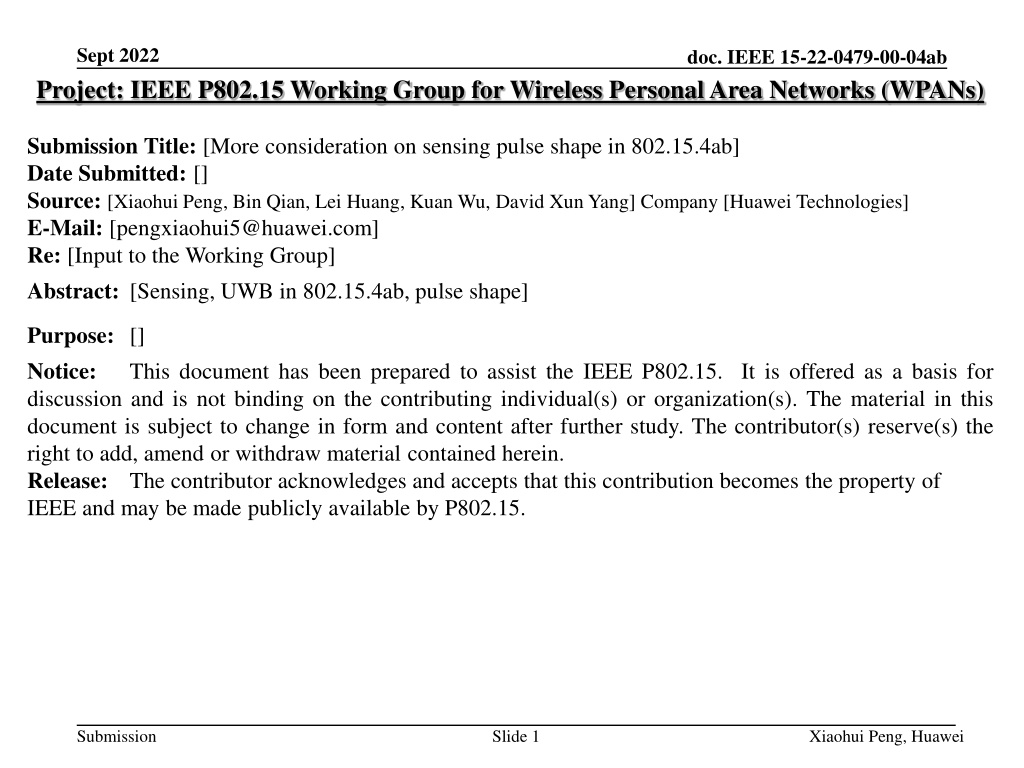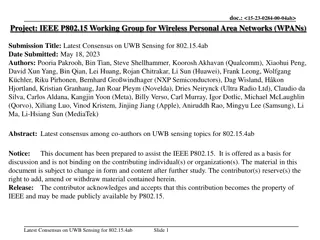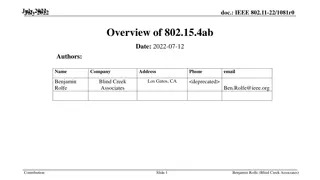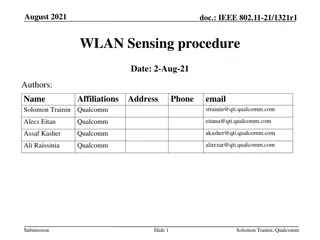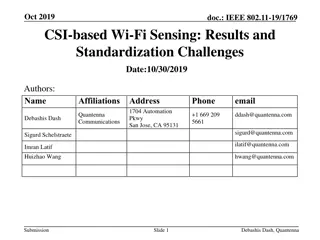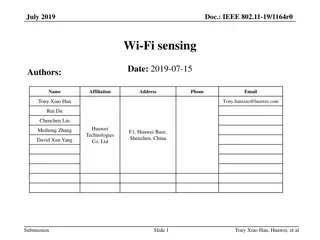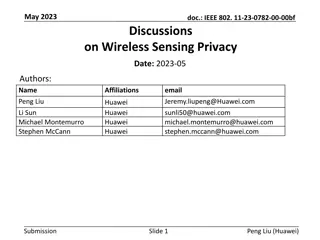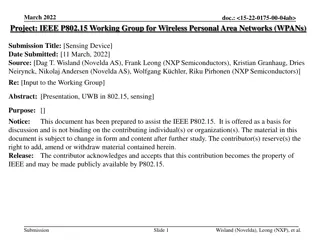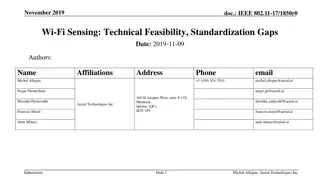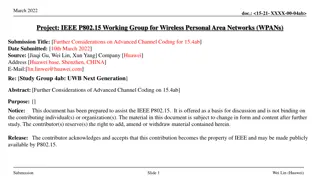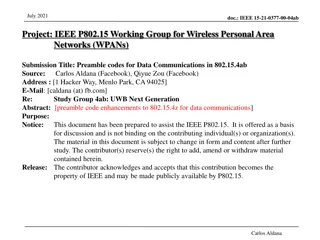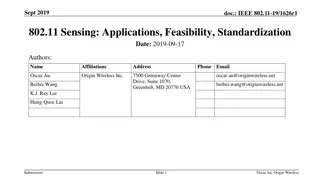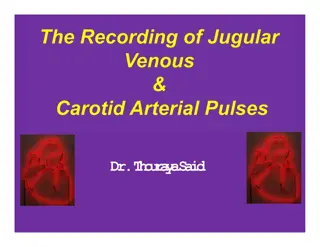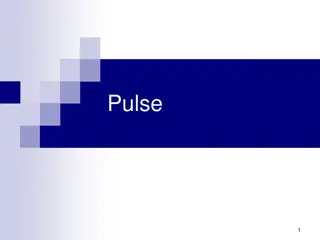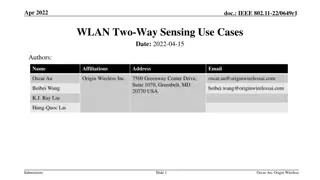Sensing Pulse Shape in IEEE 802.15.4ab Networks
This document discusses considerations related to sensing pulse shape in IEEE 802.15.4ab networks, focusing on UWB technology and its impact on high throughput data use cases, interference mitigation techniques, coexistence improvements, and more.
Download Presentation

Please find below an Image/Link to download the presentation.
The content on the website is provided AS IS for your information and personal use only. It may not be sold, licensed, or shared on other websites without obtaining consent from the author.If you encounter any issues during the download, it is possible that the publisher has removed the file from their server.
You are allowed to download the files provided on this website for personal or commercial use, subject to the condition that they are used lawfully. All files are the property of their respective owners.
The content on the website is provided AS IS for your information and personal use only. It may not be sold, licensed, or shared on other websites without obtaining consent from the author.
E N D
Presentation Transcript
Sept 2022 Project: IEEE P802.15 Working Group for Wireless Personal Area Networks (WPANs) doc. IEEE 15-22-0479-00-04ab Submission Title: [More consideration on sensing pulse shape in 802.15.4ab] Date Submitted: [] Source:[Xiaohui Peng, Bin Qian, Lei Huang, Kuan Wu, David Xun Yang] Company [Huawei Technologies] E-Mail: [pengxiaohui5@huawei.com] Re: [Input to the Working Group] Abstract: [Sensing, UWB in 802.15.4ab, pulse shape] Purpose: [] Notice: discussion and is not binding on the contributing individual(s) or organization(s). The material in this document is subject to change in form and content after further study. The contributor(s) reserve(s) the right to add, amend or withdraw material contained herein. Release: The contributor acknowledges and accepts that this contribution becomes the property of IEEE and may be made publicly available by P802.15. This document has been prepared to assist the IEEE P802.15. It is offered as a basis for Submission Slide 1 Xiaohui Peng, Huawei
Sept 2022 doc. IEEE 15-22-0479-00-04ab PAR Objective Proposed Solution (how addressed) Safeguards so that the high throughput data use cases will not cause significant disruption to low duty-cycle ranging use cases Interference mitigation techniques to support higher density and higher traffic use cases Other coexistence improvement Backward compatibility with enhanced ranging capable devices (ERDEVs) Improved link budget and/or reduced air-time unified pulse shape for ranging and sensing Additional channels and operating frequencies Improvements to accuracy / precision / reliability and interoperability for high-integrity ranging Reduced complexity and power consumption Hybrid operation with narrowband signaling to assist UWB Enhanced native discovery and connection setup mechanisms Sensing capabilities to support presence detection and environment mapping Low-power low-latency streaming Pulse shape design for sensing Higher data-rate streaming allowing at least 50 Mbit/s of throughput Support for peer-to-peer, peer-to-multi-peer, and station-to- infrastructure protocols Infrastructure synchronization mechanisms Submission Slide 2 Xiaohui Peng, Huawei
Sept 2022 doc. IEEE 15-22-0479-00-04ab Related Submissions 15-19-0443-01-004z text to address comment id r1-0820 (Michael McLaughin) 15-20-0084-00-004z pulse shaping considerations (Jochen Hammerschmidt) 15-20-0086-00-004z proposed pulse shape text changes for HRP UWB PHY (Michael McLaughin) 15-20-0089-01-004z pulse shape text changes for HRP UWB PHY (Michael McLaughin) 15-22-0040-04-04ab waveform design for UWB sensing (Xiaohui Peng) 15-22-0418-00-04ab sensing pulse shape consideration in 802.15.4ab (Xiaohui Peng) 15-22-0175-00-04ab sensing device (Dag T. Wisland ) 15-22-0061-00-04ab sensing continued (Frank Leong) 15-22-0305-00-04ab a summary of proposals and interests (Billy Verso) Submission Slide 3 Xiaohui Peng, Huawei
Sept 2022 doc. IEEE 15-22-0479-00-04ab Recap For sensing application, a pulse shape should be designed to minimize both precursor and postcursor The pulse shape should be designed to support both ranging and sensing applications in one packet The specific criteria for sensing pulse shape include range resolution, PSLR (Peak to sidelobe ratio) of the zero-Doppler ambiguity function, spectrum efficiency (or root mean square bandwidth) A more restrictive time-domain mask should be specified for the sensing pulse shape than ranging Submission Slide 4 Xiaohui Peng, Huawei
Sept 2022 doc. IEEE 15-22-0479-00-04ab Motivation Ranging-only application: it should be designed to minimize precursor Pulse shape Resolution (ns) PSLR (dB) Spectrum efficiency 5th order Butterworth 1.671 16.02 73.92% 6th order Butterworth 1.698 15.21 73.32% 7th order Butterworth 1.720 14.71 72.83% 8th order Butterworth 1.728 14.38 72.25% 9th order Butterworth 1.741 14.15 71.72% 10th order Butterworth 1.747 14.00 71.58% 11th order Butterworth 1.760 13.51 63.51% Unified pulse shape for sensing and ranging: it should be designed to minimize both precursor and postcursor Gaussian pulse 8.2e-10 1.926 322.56 52.24% Gaussian pulse 8.5e-10 1.998 323.07 50.29% Compared with the pulse shape used only for ranging, the spectrum efficiency (or root mean square bandwidth) of a unified pulse shape for sensing and ranging will decrease, which may degrade the ranging performance. Thus, the impact of pulse shape on ranging accuracy is analyzed through theoretical bound. Submission Slide 5 Xiaohui Peng, Huawei
Sept 2022 doc. IEEE 15-22-0479-00-04ab Sensing pulse shapes Time bounded Gaussian pulse a Gaussian pulse is shaped as a Gaussian function with no precursor and postcursor. It can be expressed as: ?(?) = ?? ?2 2?2, ? ?/2 ? > ?/2 0, ???? 2.355? where A is the amplitude and ? is related to the full- width at half-maximum FWHM 2.355?. (FWHM), i.e., Time bounded Kaiser pulse a Kaiser pulse is shaped as a Kaiser-Bessel window also with no precursor and postcursor. It can be expressed as: 2 2? ? ?0?? 1 1 ? 0, ?(?) = , ? ?/2 ?0?? ? > ?/2 where I0 is the zeroth-order modified Bessel function of the first kind. L is the window duration, ? = ?? is a parameter determining the shape of the pulse. Submission Slide 6 Xiaohui Peng, Huawei
Sept 2022 doc. IEEE 15-22-0479-00-04ab Sensing pulse shapes The pulse shape is time-bounded with L = 3 chips. Both the Gaussian pulse shape and the Kaiser-window pulse shape are with no precursor and postcursor. The spectrum of the Gaussian pulse shape and Kaiser pulse shape are almost the same. Submission Slide 7 Xiaohui Peng, Huawei
Sept 2022 doc. IEEE 15-22-0479-00-04ab Pulse shape impact on ranging accuracy CRLB (Cramer-Rao Lower Bound): It sets a lower bound on the mean-squared- error (MSE) of an unbiased estimator, and maximum likelihood(ML) estimators can achieve this bound asymptotically under certain conditions. + ?2??(?) ?? + ??(?) ?? 1 ?2= ???? = 8?2?2??? ZZLB (Ziv-Zakai Lower Bound): The CRLB can yield quite tight limits on time- delay or range estimation in high SNR scenarios. However, for moderate and low SNRs, The CRLB may result in a loose limit for MSEs of unbiased time-delay estimators. Unlike the CRLB, the ZZLB can provide tight limits for a wide range of SNRs. ?? 1 ?? ????= ? ??? 1 ??? ???? = ? ?? ? ???? ? ?? 0 Where Q(.) is the Gaussian Q-function and ??(?) is the autocorrelation function of p(t). [0,Ta] denote the a prior interval for the estimation problem. Submission Slide 8 Xiaohui Peng, Huawei
Sept 2022 doc. IEEE 15-22-0479-00-04ab Pulse shape impact on ranging accuracy For high SNR condition, the time-delay RMSE (root mean square error) of the sensing pulse shape is about 28% larger than the 5th order Butterworth pulse shape in term of CRLB. For low SNR condition, the time-delay RMSE (root mean square error) of the sensing pulse shape and the 5th order Butterworth pulse shape are almost the same in term of ZZLB. The time-delay RMSE (root mean square error) of the Gaussian pulse shape and the Kaiser pulse shape are almost the same either in terms of CRLB or ZZLB. Submission Slide 9 Xiaohui Peng, Huawei
Sept 2022 doc. IEEE 15-22-0479-00-04ab Summary For high SNR condition, using a unified pulse shape for sensing and ranging will sacrifice the ranging performance in terms of CRLB. For low SNR condition, using a unified pulse shape for sensing and ranging has no impact on the ranging performance in terms of ZZLB. The Gaussian pulse shape and the Kaiser pulse shape have the same performance either in terms of CRLB or ZZLB. We recommend to define a more restricted time-domain mask with bounded sidelobe level in 15.4ab, which can cover the existing two time-bounded pulse shapes (the Gaussian pulse shape and the Kaiser pulse shape). Submission Slide 10 Xiaohui Peng, Huawei
Sept 2022 doc. IEEE 15-22-0479-00-04ab References 1. Amendment1: Enhanced ultra wideband (UWB) physical layers (PHYs) and associated ranging techniques IEEE standard for low-rate wireless networks UWB spectral mask and FFC part 15 limits 15-19-0443-01-004z text to address comment id r1-0820 (Michael McLaughin) 15-20-0084-00-004z pulse shaping considerations (Jochen Hammerschmidt) 15-20-0086-00-004z proposed pulse shape text changes for HRP UWB PHY (Michael McLaughin) 15-20-0089-01-004z pulse shape text changes for HRP UWB PHY (Michael McLaughin) 15-22-0040-04-04ab waveform design for UWB sensing (Xiaohui Peng) 15-22-0175-00-04ab sensing device (Dag T. Wisland ) 10. 15-22-0061-00-04ab sensing continued (Frank Leong) 11. 15-22-0305-00-04ab a summary of proposals and interests (Billy Verso) 12. Chazan, Dan, Moshe Zakai, and Jacob Ziv. "Improved lower bounds on signal parameter estimation." IEEE transactions on Information Theory 21.1 (1975): 90-93. 2. 3. 4. 5. 6. 7. 8. 9. Submission Slide 11 Xiaohui Peng, Huawei
